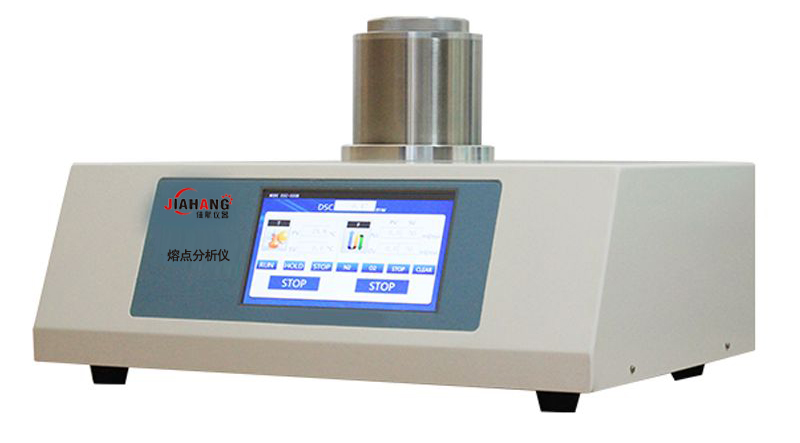May 06, 2025
Tag:

The principle of measuring plastics with the Shanghai Jiahang JH500A fully automatic melting point apparatus
In the production, processing and research of plastics, accurately determining the melting point of plastics is an extremely crucial task. Melting point, as one of the important physical properties of plastics, not only reflects the chemical structure and molecular arrangement of plastics, but also has a profound impact on the molding processing conditions of plastics and the performance of the final product. The JH500A fully automatic melting point apparatus produced by Shanghai Jiahang Instrument & Meter Co., Ltd. has become a powerful tool for accurately determining the melting point of plastics with its advanced technology and outstanding performance. Next, we will delve into the principle by which it measures the melting point of plastics.
Basic Principles of Thermal Analysis
The melting point of a substance is the temperature at which the solid and liquid states of a pure substance are in equilibrium under a certain pressure. For plastics, their melting points also follow this basic definition. When plastic samples are heated, the plastic molecules absorb heat and the thermal motion of the molecules gradually intensifies. Before reaching the melting point, plastic molecules mainly vibrate near the lattice positions, and the relative positions between molecules are relatively fixed, so the plastic is in a solid state. As the temperature keeps rising, when it reaches the melting point, molecules gain sufficient energy to overcome the intermolecular forces and start to move relatively freely. Plastic gradually changes from a solid state to a liquid state, and this transformation process is accompanied by obvious thermal effects.
The JH500A fully automatic melting point apparatus is precisely based on thermal analysis technology. By precisely controlling the heating process of plastic samples and simultaneously monitoring the temperature and state changes of the samples in real time, it determines the melting point of the plastic. This instrument can provide a stable and precisely controllable heating environment, ensuring that plastic samples are heated in a uniform temperature field and avoiding measurement errors caused by uneven local heating.
Differential thermal measurement method
The JH500A fully automatic melting point apparatus directly measures the sample temperature by differential thermal method. The principle of differential thermal measurement is to use two temperature probes. One directly measures the temperature of the sample, and the other measures the temperature of the reference substance that is in the same heating environment as the sample but does not undergo phase change. By comparing the difference between the sample temperature and the reference material temperature (i.e., the differential thermal signal), the thermal changes of the sample during the melting process can be captured more sensitively.
During the gradual heating process of the plastic sample, when the sample does not undergo phase transformation, the temperature changes of the sample and the reference substance are basically the same, and the differential thermal signal is close to zero. However, once the sample begins to enter the melting stage, due to the heat absorption required by the phase transition, the heating rate of the sample will temporarily slow down, generating a temperature difference with the reference substance, and thereby generating a differential thermal signal. Through precise detection and analysis of differential thermal signals, the instrument can accurately determine the starting and ending points of the sample's melting, thereby determining the initial and final melting temperatures of the plastic. This differential thermal measurement method greatly enhances the measurement accuracy and repeatability, and can effectively distinguish the subtle differences in melting characteristics among different plastic samples.
High-precision temperature control technology
Precise temperature control is one of the key links in accurately measuring the melting point of plastics. The JH500A fully automatic melting point apparatus integrates advanced high-precision temperature control technology, enabling precise regulation of the heating process. This instrument adopts high-performance heating elements and a precise temperature control system, which can linearly heat the sample according to the preset heating rate. Users can flexibly select the appropriate heating rate based on the characteristics of different plastic samples to ensure that the melting process of the samples can be clearly and accurately observed.
For example, for some plastic samples with a narrow melting point range and a relatively rapid melting process, a slower heating rate can be selected in order to capture the melting point temperature more accurately. For plastic samples with a wide melting point range or complex melting processes, the heating rate can be appropriately increased to enhance the measurement efficiency while ensuring measurement accuracy. Meanwhile, the temperature control system of the instrument features excellent stability and response speed. It can quickly adjust the heating power to maintain the set heating rate. Even when the sample undergoes phase change and absorbs a large amount of heat, it can ensure a stable temperature rise, providing a reliable guarantee for accurately measuring the melting point.
Optical monitoring and condition judgment
In addition to thermal analysis and temperature control technology, the JH500A fully automatic melting point apparatus is also equipped with a highly sensitive optical monitoring system for real-time observation of the state changes of plastic samples during the heating process. During the melting process of plastics, their optical properties will change significantly. When plastic is in a solid state, light propagates within it and is scattered and absorbed by the molecular lattice structure, resulting in a relatively weak light intensity passing through the sample and the sample appearing opaque or semi-transparent. As the temperature rises, the plastic begins to melt, the lattice structure between molecules gradually breaks down, the obstruction of light propagation within it decreases, the intensity of light passing through the sample increases, and the sample gradually becomes transparent.
The optical monitoring system of the instrument can capture these optical changes in real time and convert them into electrical signals to be transmitted to the control system of the instrument. The control system, through the analysis and processing of these electrical signals, combined with differential thermal signals and temperature data, can accurately determine the melting process of plastic samples and determine the initial and final melting moments. This combination of optical monitoring and thermal analysis further enhances the accuracy and reliability of melting point measurement, especially for plastic samples with significant changes in optical properties such as color and transparency during the melting process, which can provide more intuitive and accurate measurement results.
Data processing and result output
After the melting point measurement of the plastic sample is completed, the data processing system built into the JH500A fully automatic melting point tester will conduct a comprehensive analysis and processing of the large amount of collected data. The instrument can automatically calculate and record the initial melting temperature, final melting temperature and melting distance (i.e., the difference between the initial melting temperature and the final melting temperature) of the plastic. These data are of great significance for evaluating the purity and quality of the plastic. Generally speaking, plastic samples with higher purity have a relatively narrow melting point range and a smaller melting distance. For plastic samples containing impurities or with a wide molecular weight distribution, their melting point range may become wider and the melting distance may increase.
Meanwhile, the instrument also has powerful data storage and output functions. The measurement results can be directly displayed on the instrument's screen, making it convenient for users to view them immediately. In addition, the instrument also supports connection with a computer, and the measurement data can be transmitted to the computer through the accompanying software for further analysis, processing and storage. Users can generate detailed experimental reports as needed. The reports not only include specific data on melting point measurement but also can attach information such as temperature change curves, differential thermal signal curves, and image records of sample state changes during the measurement process, providing comprehensive and detailed data support for plastic research, quality control, and process optimization.
In conclusion, the JH500A fully automatic melting point apparatus of Shanghai Jiahang Instrument & Meter Co., Ltd. can accurately, stably and reliably determine the melting point of plastics through the combined effect of a series of advanced technologies such as thermal analysis, differential thermal measurement, high-precision temperature control, optical monitoring and data processing. In every link of the plastic industry, including research and development, production and quality inspection, this instrument plays a crucial role, providing strong technical support for the continuous development and innovation of plastic technology.


Contact Us
Tel: (+86) 400 610 1188
WhatsApp/Telegram/Wechat: +86 13621645194
+86 15021993094
Follow Us:




 Pharma Sources Insight January 2025
Pharma Sources Insight January 2025


